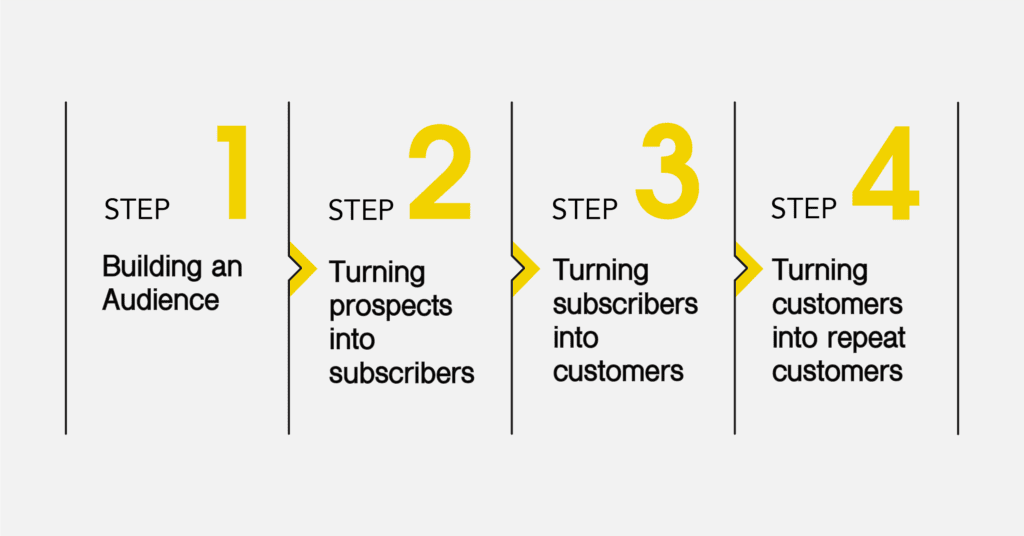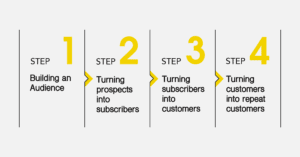Apr. 29, 2021

The 4 Step System to Convert Subscribers Into Customers
What is the best channel to generate customer conversion? This is a question that a lot of people have already asked me.
The problem is that, by nature, without context, the question is wrong. There are many variables that will shape the best strategy to compose an effective plan to convert people not familiar with your brand into paid customers. And hopefully later, into repeat customers.
A system is needed to organize all possible initiatives to reach your audience and convince them to pay attention to you. The journey to create trust and move people towards your offer takes time. That said, prioritizing what is important at each stage will determine your level of success.
In today’s article, I would like to share with you some tips to compose a 4 step system to convert subscribers into customers. Consider as a starting point to figure out what is needed, what comes first and what is important for later.
Here is the 4 step system to convert subscribers into a customer:
Step 1: Building an audience.
Step 2: Turning prospects into subscribers.
Step 3: Turning subscribers into customers.
Step 4: Turning customers into repeat customers.
Step 1: Building an audience
This is the ground level. The stage where the goal is to make your audience perceive and acknowledge your existence.
Like the old saying goes, you never get a 2nd chance to make a 1st impression. The same is true when you are building your audience.
Be clear about your value proposition; explaining how your offer will solve your customer’s problem is crucial to associate their minds with you.
Consider here all awareness initiates that would make people understand how your product and services can make their lives better.
Videos, for instance, are a great way to introduce your brand engagingly in social media, your website, or even in email marketing initiatives.
Step 2: Turning prospects into subscribers
The second step is regarding the process of turning potential customers into subscribers, including them in your regular communications about your brand.
But to make it happen, a lead generator, as well known as a lead magnet, is required to motivate people to provide their personal contact information in exchange for some sort of document or content asset relevant from their perspective.
Lead generators are helpful as well to test your audience’s adherence to a particular topic that you could use to refine your marketing strategy.
As an example, a lead generator could be a checklist to help your audience identify the best solution for their problem, or a guide, providing the directions to execute some sort of task. Perceived value is key here, creating enough engagement to make the person share with others and making more people aware of your offer.
Include your lead generator link wherever your brand is, such as email signatures, websites, social media profiles, etc. Even in printed materials, you can make them available using QR codes.
Step 3: Turning subscribers into customers
Here is where the first sale happens. Consider here all the initiatives that will help educate your subscriber about our offer.
At this stage, nurture campaigns are effective to illustrate your product advantages versus other alternatives. It is the moment as well to overcome customer objections that normally postpone closing sales.
When composing your sales message on this step, ensure that you have covered all relevant factors required in a typical transaction, such as but not limited to, why your alternative vs other, cost, how it works, benefits, testimonials, etc.
Put yourself in your customer’s shoes. Think about all the possible questions a potential customer might ask when assessing your offer, including the answers in your sales message.
Step 4: Turning customers into repeat customers
The final step corresponds to the initiatives that will encourage your current customer to buy more from you. The same stage would include the customers that would recommend your brand to others. The most critical component to incentivize the most powerful marketing channel: “word of mouth.”
In short, in the last step, the level of trust and satisfaction should be strong enough, making people not think of alternatives rather than you to solve the problem you solve. It is the stage of recognition that your brand is doing a great job in alignment with the needs of its audience.
Some studies indicate that acquiring a new customer can cost five times more than retaining an existing one. Try to map out possibilities to delight your current client list, creating brand ambassadors of your company.
It is a great moment to revisit your client’s needs as well, helping them to overcome possible new challenges with other services or products you may already offer, or creating customized solutions if applicable.
Takeaways
A productive brainstorming session may provide hundreds of good ideas to help you in customer conversions. To organize them logically, try to list them based on the step-by-step system mentioned above.
You should be able to identify priorities, supporting your planning and implementation process.
It may help your team as a communication tool, bringing clarity when composing a marketing plan for your organization.
For more expert digital marketing tips or guidance to structure your marketing strategy, contact us today!
Book with us
Let’s accomplish what you are looking for, our team of experts are here for you.
Let's work togetherWarning: Working with our team may result in excessive creativity, uncontrollable 'aha' moments, and an addiction to perfect pixels. Please proceed with caution.



